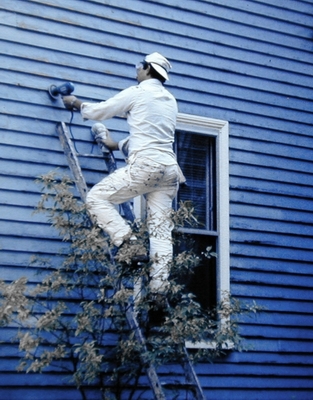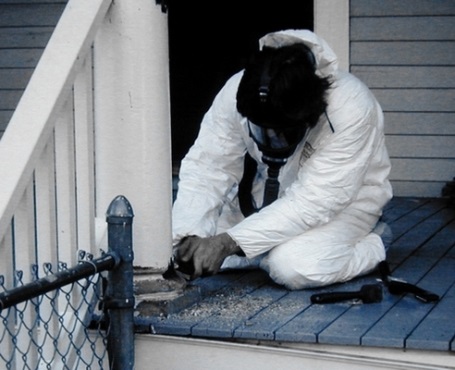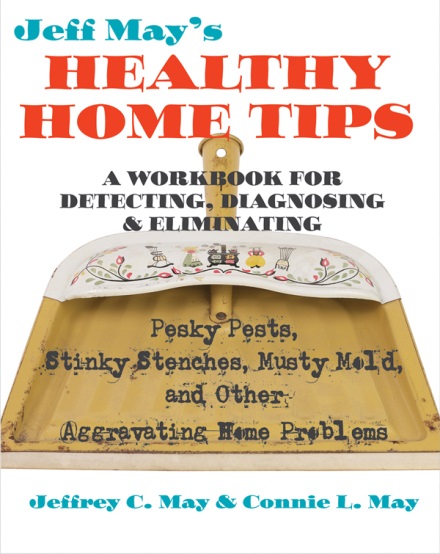IAQ IQ Summer 2018
©2018 Jeffrey C. May
Of all the environmental hazards in homes, lead paint is one of the most serious. Lead-poisoned children number in the tens of thousands and suffer from reduced learning skills, behavioral and nervous-system disorders, and in the worst cases of poisoning, mental retardation. Lead can also affect unborn children.
As I am sure you all know, up until 1978, nearly all exterior paints and most interior wood-trim paints contained lead pigment. I consider lead dust an environmental hazard, and many of you may inspect homes that have lead paint. The issue, therefore, is relevant to both home inspectors and indoor-air-quality professionals.
The Lead-Paint Myth
One of the most widely believed “myths” is that lead paint tastes sweet, and therefore children eat it and can become lead-poisoned.
In order for something to taste sweet, it must be soluble in water as well as in our saliva, which contains water. Sugar and all artificial sweeteners dissolve in water, so when added to foods (which contain varying amounts of water), they make the foods taste sweet or sweeter. If these chemicals did not dissolve in our saliva, they could not possibly produce the sensation of sweetness in our mouths.
I am wearing my “chemist” hat in this discussion.
Paints are primarily a mixture of pigment and a liquid vehicle that either dries or hardens, sticking to a surface. The purpose of the pigment is either to color the surface in the first place, or hide the color that the surface already has. For centuries, white lead pigment was used in paint, because it had a strong hiding power. The most common white-colored lead pigment used was lead carbonate. This compound, no longer added to paint, is completely insoluble in water and therefore cannot possibly be sweet.
Another product that was phased out of use in the 1980s is paint containing lead chromate, which gives the paint a vivid yellow color. Like lead carbonate, lead chromate is insoluble in water and thus can’t taste sweet.

When paints were formulated with linseed oil and lead pigments, a very small amount of a chemical called “sugar of lead” was sometimes added to the paint to make it harden faster. The chemical name for sugar of lead is “lead acetate.”
Lead acetate forms when grape extracts are fermented in lead containers to make wine or vinegar. If the wine or vinegar is boiled out of the container, a thick syrupy liquid called
“sapa” is left. Sapa contains lead acetate and is sweet; it was used to sweeten foods and no doubt caused many cases of lead poisoning. But lead acetate is no longer added to paints (nor sapa to foods, for that matter).
Do hungry children eat lead paint?
The amount of lead acetate in paint was miniscule – certainly not enough to make lead paint taste sweet. I proved this first-hand. When I was much younger, I started a wood-refinishing business to test out a method I invented to remove paint. I frequently had the “opportunity” to deal with lead paint; on several occasions, I cautiously “tasted” some of the paint chips. I never tasted a sweet chip.
So I do not believe that children are lead poisoned because they eat lead paint. I do believe, however, that dust and soil containing lead are worrisome culprits.
Children can be lead poisoned if a property has been sloppily de-leaded, and there is lead dust remaining on interior surfaces. Then they can get that dust on their toys and fingers, and from fingers to mouth. They can also inhale the dust.
If lead paint is scraped off the exterior of an older home, and lead dust falls to the soil below, then children who play in the yard could conceivably be exposed to lead in the dirt.


Despite any requirements for lead-paint disclosure forms in real estate transactions, you can still give helpful advice to your Clients about lead paint, whether you conduct lead-paint testing or not.
If your Clients are considering purchasing an older home that has not been de-leaded, they should not try to de-lead it themselves. If you inspect a home that has been de-leaded, encourage your Clients to find out whether professionals did the job, and whether surfaces in the house were thoroughly cleaned afterwards to remove all dust. They might still consider that the dust on various surfaces be tested for lead. This would include carpeting, since the fibers capture dust.
If your Clients are considering purchasing an older home (constructed prior to 1978), they should have the soil around the house’s perimeter tested for lead, especially if they have or are planning to have children, and/or if they are planning to have a garden. If the soil around the house contains lead, they should not let their children play in the dirt; they should plant their garden in raised beds with soil they purchase for this purpose; and they and their guests should remove their shoes when they first enter the home.
The Power of Myths
The lingering belief that lead paint tastes sweet is an example of the persistent power of myths.
Here is another myth whose survival I find surprising. For over a century, ever since the famous German chemist Justus Liebig declared that searing meat seals in the juices, practically every cookbook encouraged cooks to take this step. Only in the last few decades has it been proven that searing meat at the start of cooking does not prevent the loss of juices. Anyone who has ever barbecued a piece of meat and then placed it on a platter afterwards cannot fail to see that juice runs out of the well-seared meat.
This reminds me of a joke I heard years ago about a conversation between a little girl and her mother.
Little girl: “Mommy, why do you cut the end of the roast off before putting it in the baking pan?”
Mom: “Maybe it’s because my mother does that. Let’s call Grandma and ask her.”
Little girl to Grandma: “Grandma, why do you cut the end of the roast off before putting it into the baking pan?”
Grandma: “I guess that’s because my mother does that. Let’s call Great Grandma and ask her.”
Little girl to great grandma: “Great Grandma, why do you cut the end of the roast off before putting it into the baking pan?”
Great Grandma: “Well…….because my pan is too small.”
And on it goes!

If your clients have concerns about the quality of their indoor environments, encourage them to refer to our book Jeff May’s Healthy Home Tips (published by The Johns Hopkins University Press and available on Amazon.com). This workbook can help your clients keep track of the steps they can take and have taken to improve the indoor air quality in their homes.
